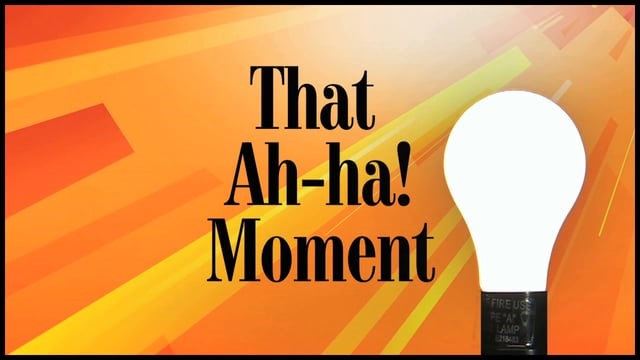“Aha!” moments often arise when we take a break from unhelpful problem-solving.
SUMMARY
- When trying unsuccessfully to solve a problem, taking a break can free us up to “aha!” moments.
- Researchers call these breaks from conscious problem solving “incubation” periods.
- One theory is that our unconscious mind continues to work on the problem, free from interference from our conscious mind’s unhelpful strategies.
- If you can’t think your way to a solution, try taking a break. You’ll lower your stress and frustration, and the solution you’re seeking may appear.
“If you find yourself in a hole, stop digging.” –Will Rogers
Sometimes, when I’ve been struggling unsuccessfully to find a solution to a problem, and focusing on it endlessly has only gotten me increasingly frustrated, I step away from the computer, maybe even turn it off. If I’ve been walking around obsessively thinking about the problem, I step away from my rumination. It often takes a great effort to step back, and my mind pulls hard to return to thinking about the problem, stubbornly sure I’ll find a solution if I just keep focusing on it. But I know that whatever I’m doing to solve the problem isn’t working, and I need a break. Will Rogers once said, “If you find yourself in a hole, stop digging.” It’s no easy thing, but it can work wonders.
Usually, I lace up my sneakers and head out to the park for a run.
My rule when running is to stay focused on the here-and-now, something I call “mindful running.” I don’t allow myself to continue thinking about whatever problems or worries have occupied my mind. Instead, I focus on the trees and small ponds, the feel of my feet leaving and landing on the path, the sounds of kids playing or birds chirping, or the sensation of my breath. It calms me down, gets me in touch with something core, and I can feel the stress gradually peel away. Often, I catch myself returning to the problem I was struggling with, and have to refocus on the here and now. It gets easier with practice.
And then, sometimes, something remarkable happens as I run. The solution to my problem pops into my head, seemingly out of nowhere, in the most amazing “aha!” sort of way.
Psychologists call this sort of solution a form of insight or, more descriptively, an “aha!” moment. But what I really want to focus on is the process leading up to the insight: something researchers call an incubation effect.
There’s agreement that the incubation effect is real, though disagreement about why it occurs or how to explain it (Davidson, 2003). One theory is that by breaking the “mental set,” that is, by stepping back from problem-solving strategies that just aren’t working, we clear our mind and open ourselves up to new ways of viewing the problem.
Understanding Unconscious Work
Of particular interest is the of idea “unconscious work”—the theory that when we clear our head and focus on something else, our unconscious mind continues exploring the problem without the interference from our conscious mind’s unhelpful problem-solving strategies.
There’s actually good support for this “unconscious work” theory and it resonates for me. Those moments of amazing insight have an organic quality to them, as though the answer has come from deep within. And more often than not, the answer or solution is a good one. This is true whether the problem is a research question, a relationship issue, or something related to my career.
My friend and colleague Andy sometimes has these “aha!” moments in the shower. We were about to publish a paper together based on some research we’d done in Afghanistan. The draft was done, and ready to be submitted to a journal. But something bothered Andy about our results, though he couldn’t figure out what. Finally, he took a break from trying. Soon after, during a relaxing morning shower, he suddenly saw the answer with absolute clarity. We’d gotten one key finding wrong, by interpreting the results of a statistical analysis incorrectly. Once Andy saw that, we fixed the problem, and the findings made complete sense.
A Mindfulness-based Explanation
As a practitioner of mindfulness and mindfulness-based psychotherapy, I suspect that there’s another factor at play in some of these seemingly out-of-the-blue insights and solutions, particularly when it concerns problems that have a strong emotional component. By shifting our attention away from the problem that’s vexing us, we quiet the mind and turn down the volume on our thinking. That opens up a space to listen more closely to what we are feeling, to hear our own inner wisdom. When we find ourselves unable to think our away through a problem, it may be that thinking isn’t really the path we need to be on. Listening to our feelings, seeing and accepting what we find in our hearts, can help us get unstuck and point the way forward.
The takeaway
Human beings are great problem-solvers, and our usual problem-solving strategies generally work well for us. But if you find yourself deeply stuck, unable to solve a problem and just getting more frustrated the longer you think about it, stop.
Really, stop.
Take a break. A real break. Do something else that genuinely clears your mind. Take a walk, go for a run, play some music, watch a sitcom, cook a meal. It doesn’t matter. Just take a mental break that lets you clear your mind.
At the very least, you’ll lower your stress level and stop digging an unhelpful hole. And maybe, just maybe, that elusive answer will appear in your mind, an “aha!” moment you couldn’t have experienced any other way.
References
Davidson, J. (2003). Insights about insightful problem solving. In J. Davidson and R. Sternberg (eds.), The psychology of problem solving (pp. 149-175). Cambridge: Cambridge University Press.
Author
Kenneth E. Miller, Ph.D., is a Senior Researcher at War Child Holland and a writer currently based in Amsterdam.




